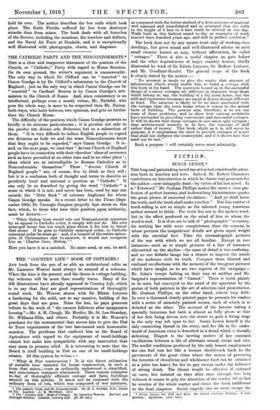Here you have it in a nutshell. No more need, or can, be said.
THE " COUNTRY MEE " BOOK OF COTTAGES.t ANY book from the pen of so able an architectural critic as Mr. Laurence Weaver must always be assured of a, welcome. When the time is the present, and the theme is cottage-building, the welcome will be more than usually warm. Many of the 300 illustrations have already appeared in Country Life, which is to say that they are good representations of thoroughly sound work. Mr. Weaver shares with Sir Edwin Lutyens a hankering for the solid, not to say massive, building of the great days that are gone. None the less, he pays generous tribute to the work of " the earnest followers after inexpensive housing "—Mr. A. H. Clough, Mr. Horder, Mr. St. Loe Strachey, Mr. Williams-Ellis, and others. Probably it is Mr. Weaver's
penchant for the monumental that moves him to give the Piss de Terre experiments of the two last-named such honourable mention. The problems that confront him at the Board of Agriculture with regard to the equipment of small-holdings cannot but make him sympathetic with any innovation that may seem to promise relief. It is interesting to note that the Board is itself building in Pis6 on one of its small-holdings estates. Of this system he writes :
"What is Ping construction ? It is the direct utilization of suitable local material for house construction, in such a form that manuf..eture as ordinarily understood is simplified, and unnecessary transport eliminated. There remain examples to-day of thoroughly efficient cottage and farm buildings erected on this system. It mu at not be confused with the ordinary form of cob, which was composed of wet mixtures,
as compared with the better method of a drier mixture of material well rammed and consolidated and so arranged that the walls to the height of 6 feet to 8 feet could be erected in one day. Walls built in this fashion stand to-day as examples of work erected three hundred years ago, and still in perfect condition."
The book does not by any means treat only of working-class dwellings, but gives sound and well-illustrated advice on such small country houses as may, without affectation, be called " cottages." There is also a useful chapter on gate lodges and the other dependencies of larger country houses, chiefly illustrated by work of Sir Edwin Lutyens, Sir Robert Lorimer, and Mr. Goodhart-Rendel. The general scope of the book is clearly stated by the author :—
" No attempt is made to give the reader that amount of information which would enable him to build a cottage with this book in his hand. The questions bound up in the successful design of country cottages are different in character from those which belong to, say, the building of a big town house, but the skill and experience necessary are equal in degree though different in kind. The amateur is likely to be no more successful with the cottage than the town house when it comes to the actual facts of building. The present aim, therefore, is to set out some of these problems, and to show how various architects have succeeded in providing convenient and successful cottages. It will be shown that cheap cottages do not mean ugly cottages ; that architectural amenity is, in fact, the outcome of skill rather than of money. This book, slight as it is, will serve its purpose, if it emphasizes the need to provide cottages of a sort that shall not disfigure the countryside, and if it shows how that need can be met."
Such a purpose it will certainly serve most admirably.






































 Previous page
Previous page